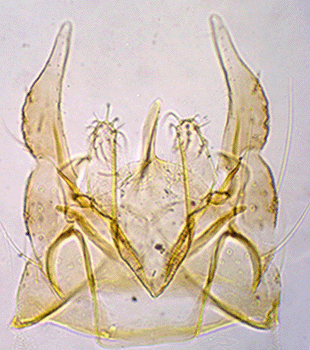|
Chironomus species nr samoensis from Jammu and Kashmir, India
Adult:
Male:
Wing length about 3.4 mm, width 0.75 mm. AR abt 2.75.
LR - 1.4; the fore Ta5 about 0.25 - 0.28 of the length of Ti.
Head: Frontal tubercles present, abt 18 - 28 µm; abt 22 - 24 clypeal setae.
Palpal proportions µm): 49 : 53 : 218 : 230 : 370
Thorax: Setae - acrostichal 14 - 16; dorsolateral 11 - 19; prealar 5 - 6; scutellar
in two or three rows, ant. row 6 - 9, post. rows 14 and/or 11 - 15.
Legs: Proportions (microns)
|
Fe
|
Ti
|
Ta1
|
Ta2
|
Ta3
|
PI
|
1255
|
1185
|
1650
|
900
|
780
|
PII
|
1365
|
1190
|
715
|
404
|
308
|
PIII
|
1495
|
1505
|
1090
|
610
|
470
|
|
Ta4
|
Ta5
|
LR
|
F/T
|
BR
|
PI
|
690
|
330
|
1.41
|
1.04
|
2.44
|
PII
|
215
|
135
|
0.57-0.63
|
1.10-1.18
|
-
|
PIII
|
285
|
170
|
0.70-0.74
|
0.98-1.01
|
-
|

Male terminalia of C. "samoensis" Note the S-type superior volsella
The superior volsella is S-type, with an extended "beak" (above); inferior volsella with forked setae; and tergite 9 has 16-18 setae (c.f. sp PK5).
Differs from C. samoensis where the frontal tubercles are longer (33 - 38 micron); the LR is greater (1.82 - 1.96); and the fore Ta5 is relatively longer (0.35 - 0.4 of the length of fore Ti).
The description of the female of that species does not mention the unusually long fore Ta4 noted by Tokunaga (1964), as characteristic of his supposed C. samoensis. AR 0.36
Pupa: Length 6.51 (5.99 - 6.61) mm in males, 7.21 (7.01 - 7.53) mm in females. Colour brown, but pupal exuviae pale brown. Frontal tubercles 75 µm long and 57 µm wide at base. Thorax rugose, wing sheath 1.69 mm long.
About 84 - 96 hooklets on tergite II, tergites II-VII with median shagreen, tergite VIII with 2 median patches of shagreen. Caudolateral spurs of segment VIII with 2 - 4 spines.
Larva: larva a small to medium (8.4 - 9.8 mm) plumosus-type. Anal tubules long, cylindrical, about 340 µm in length
Posterior third of gula dark, frontoclypeus very dark. Antenna with basal segment about 2.7 times longer than wide; AR 1.86; ratio of antennal segments (micron) 80 : 25 : 9 : 6 : 3.
Cytology: Four polytene chromosomes with the pseudothummi-cytocomplex combination BF, CD, AE, G.
Nucleolus subterminal in arm G, and also in arm F, a nucleolus sometimes developed in arm D. Nucleolus in arm G may only appear as a large puff.
Polymorphism in arm C, D and G. Although no polymorphism has been observed in arms A or B, two different homozygous sequences have been observed (associated) in different populations.
"sam"A1: 1 - 2c, 10 - 12, 3 - 2d, 9 - 4, 13 - 19 as circumdatus A2, holomelas, incertipennis, etc.
"sam"A2: 1 - 2c, 10 - 12, 3, 14c-13, 4 - 9, 2ed, 14d-19 - probably as C. nr. flaviplumus
"sam"B1: Puff (gp 7) about middle of arm, with dark bands (gp 8) proximal.
"sam"B2: Puff (gp 7) more distal, with dark bands (gp 8) distal.
"sam"C1: Typical constriction (gp 2-3) proximal.
"sam"D1:
"sam"D2: Small inversion at distal end of arm.
"sam"E1: 1-2c, 5-10b, 3e-2d, 4-3f, 10c-13 as incertipenis.
"sam"F1: 1a - 2a, 10d-a, 15 - 11, 2b - 9, 16 - 23 (not proven) as samF1.
"sam"G1: two dark bands immediately distal to nucleolus.
"sam"G2: inversion of middle third of arm.
Cytology differs from C. samoensis which, most notably, has a medial nucleolus in arm G; and from C. faviplumus which has a more terminal nucleolus in arm G, and the arm E sequence is different.
Found: India - Bishnah wetland(abt. 32.70°N, 75.00°E) (A2,B2), Deoli Village (A2,B2), Gadigagh, and Sangrampur village(A1,B1), Jammu region.
Berhampore, Farakka, and Burdwan, West Bengal (Chattopadhyay et al. 1991).
Does not appear identical to material from Japan, Korea, Java, Australia, Samoa and other Pacific Islands. Some polytene chromosome sequences are similar to those of C. flaviplumus from Japan, while the mtCOI sequences also indicate relationship.
It is likely that this species is a complex of closely related forms. The included specimens have very similar mitochondrial COI sequence (result of hybridization?), but the cytology differs (as noted above).
[ Return to Index| Go to C. samoensis
| Go to C. flaviplumus | Go to C. nr. flaviplumus | Go to C. indiaensis ]
|